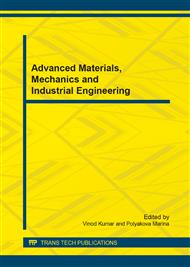[1]
Sarhan, A., Sayed, R., Nassr, A.A. and El-Zahry, R.M., Interrelationships between cutting force variation and tool wear in end-milling, Journal of Materials Processing Technology, vol. 109, pp.229-235, (2001).
DOI: 10.1016/s0924-0136(00)00803-7
Google Scholar
[2]
Polini, W. and Tuchetta, S., Force and specific energy in stone cutting by diamond mill, International Journal of Machine Tools and Manufacture, 44, 1189-1196, (2004).
DOI: 10.1016/j.ijmachtools.2004.04.001
Google Scholar
[3]
Shao, H., Wang, H.L. and Zhao, X.M., A cutting power model for tool wear monitoring in milling, International Journal of Machine Tools and Manufacture, 44, 1503-1509, (2004).
DOI: 10.1016/j.ijmachtools.2004.05.003
Google Scholar
[4]
Ertunc, H.M. and Oysu, C., Drill wear monitoring using cutting force signals, Mechatronics, vol. 14, pp.533-548, (2004).
DOI: 10.1016/j.mechatronics.2003.10.005
Google Scholar
[5]
Yesilyurt, I., End mill breakage detection using mean frequency analysis of scalogram, International Journal of Machine Tools & Manufacture 46, 450–458, (2006).
DOI: 10.1016/j.ijmachtools.2005.03.014
Google Scholar
[6]
Bhattacharyya, P., Sengupta, D. ve Mukhopadhyay, S., Cutting force-based real-time estimation of tool wear in face milling using a combination of signal processing techniques, Mechanical Systems and Signal Processing, vol. 21, pp.2665-2683, (2007).
DOI: 10.1016/j.ymssp.2007.01.004
Google Scholar
[7]
Cao, H., Chen, X., Zi, Y., Ding, F., Chen, H., Tan, J. and He, Z., End milling tool breakage detection using lifting scheme and Mahalanobis distance, International Journal of Machine Tools & Manufacture, vol. 48, pp.141-151, (2008).
DOI: 10.1016/j.ijmachtools.2007.09.001
Google Scholar
[8]
Yun, H.T., Heo, S., Lee, M.K., Min, B. K. and Lee, S.J., Ploughing detection in micro milling processes using the cutting force signal, International Journal of Machine Tools&Manufacture, 51 (5), 377-382, (2011).
DOI: 10.1016/j.ijmachtools.2011.01.003
Google Scholar
[9]
Jang, J.S.R., C.T. Sun, 1997. Neuro-Fuzzy and Soft Computing: A Computational Approach to Learning and Machine Intelligence. Prentice Hall, Englewood Cliffs, NJ.
Google Scholar
[10]
Zhang, J., He, Z.Y., Lin, S., Zhang, Y.B. and Qian, Q.Q., An ANFIS-based fault classification approach in power distribution system, Electrical Power and Energy Systems, 49, 243–252, (2013).
DOI: 10.1016/j.ijepes.2012.12.005
Google Scholar
[11]
Tahmasebi, P. and Hezarkhani A. Application of Adaptive Neuro-Fuzzy Inference System for Grade Estimation; Case Study, Sarcheshmeh Porphyry Copper Deposit, Kerman, Iran, Australian Journal of Basic and Applied Sciences, 4(3): 408-420, (2010).
Google Scholar


